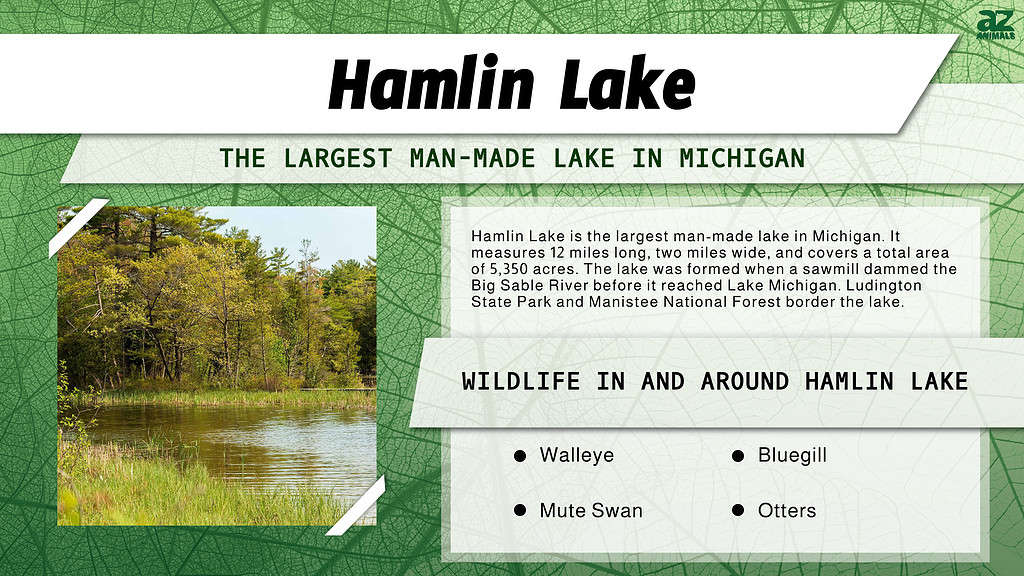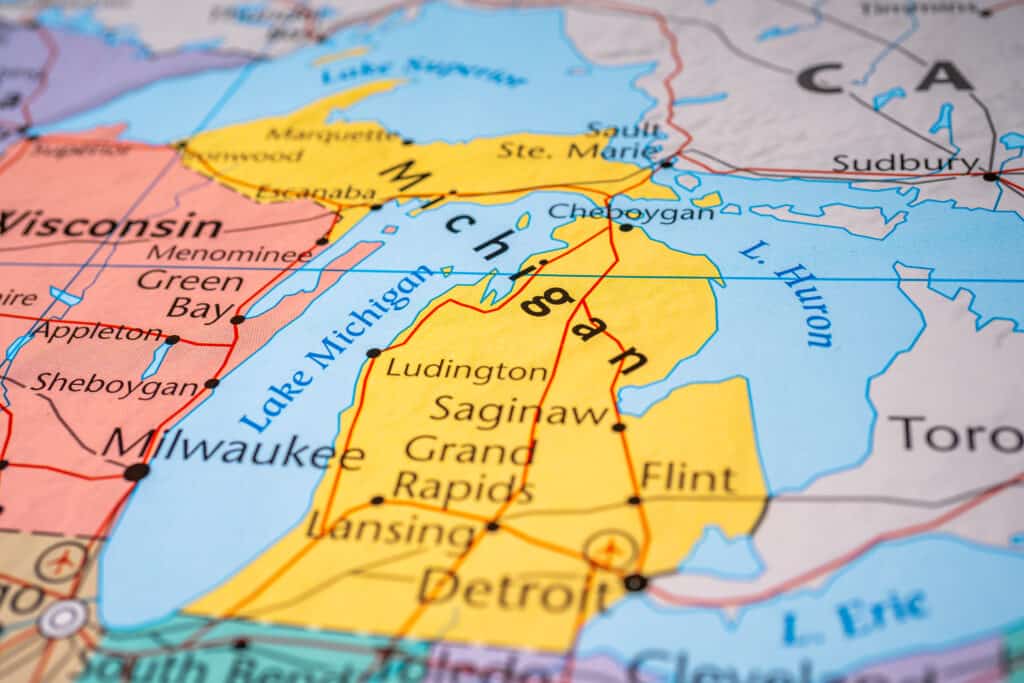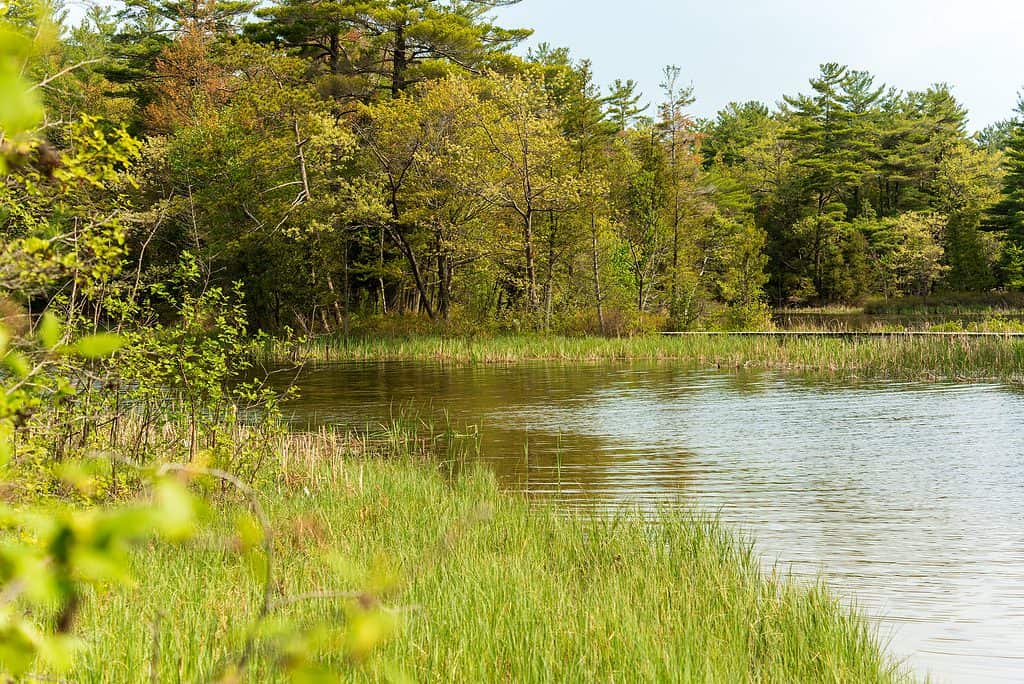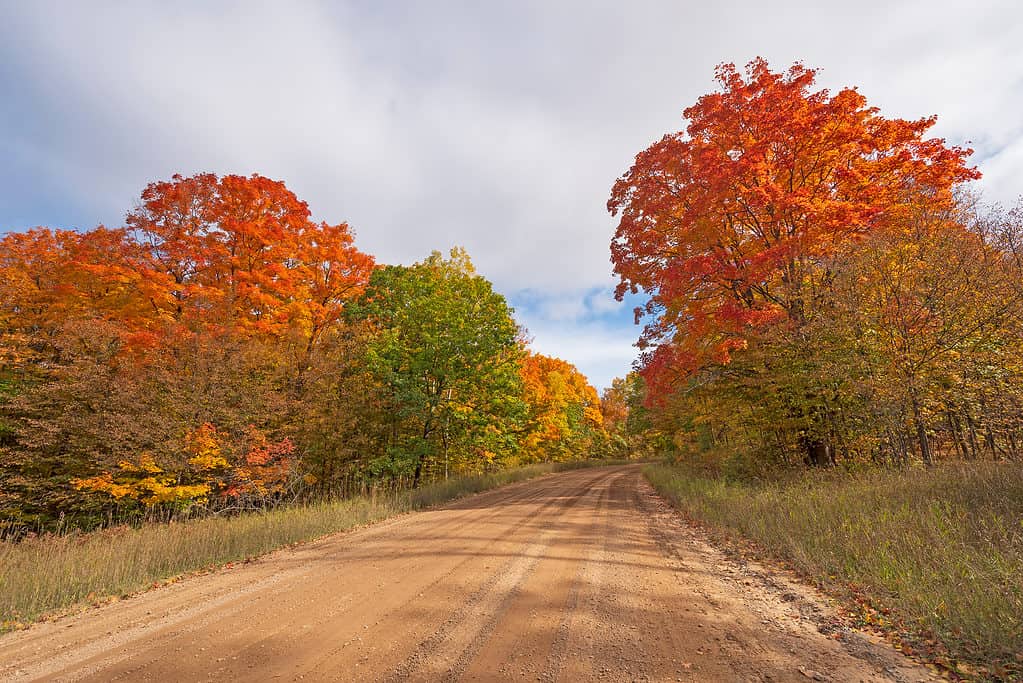
In Michigan, you’re never more than six miles away from a lake, river, or other water source. And with so many lakes, rivers, lighthouses, beautiful shorelines, and historical sites, there’s always something fun and water-related to do. That’s one of the reasons Michigan draws more than five million visitors per year! In this article, we’ll explore Hamlin Lake, the largest man-made lake in Michigan.
The Lakes of Michigan
Michigan belongs to the Great Lakes Region of the United States. Michigan is the only U.S. state that’s split into two unconnected pieces. These pieces are not islands, but an upper and a lower peninsula. Back before Michigan was a state, locals fought with Ohio over the ownership of the city of Toledo. Ohio ended up winning Toledo, but the United States government compensated Michigan with the Upper Peninsula instead.

Michigan lies at the center of the Great Lakes region and is the only U.S. state split into two unconnected parts that are not islands.
©Alexander Lukatskiy/Shutterstock.com
As a consequence of these historical shenanigans, Michigan borders four of the five Great Lakes. It has the longest coastline of any of the Great Lakes states. Additionally, it also has more than 11,000 inland lakes! Lakes are important not only to the state’s geography and history but to its economy. It’s estimated they create around 1.5 million jobs for the citizens of Michigan. These include jobs connected with recreation, such as fishing, boating, picnicking, and more.
The Largest Man-Made Lake in Michigan

Hamlin Lake is the largest man-made lake in Michigan.
©Focused Adventures/Shutterstock.com
Hamlin Lake is the largest man-made lake in Michigan. A sawmill was built in the 1850s. It dammed up the Big Sable River before it reached Lake Michigan. Hamlin Lake measures twelve miles long and two miles wide and covers a total area of 5,350 acres. It is divided into two sections separated by shallow narrows. The lower section to the east is 34 feet deep, but the western section reaches a depth of 80 feet. Ludington State Park and Manistee National Forest border the lake.

Michigan is known for its natural beauty.
©Wildnerdpix/Shutterstock.com
Wildlife Near Hamlin Lake
Fish species in Hamlin Lake include bass, perch, bluegill, crappie, pike, walleye, and muskie, among others. Nearby Ludington State Park is an excellent place to look for wildlife. It features diverse ecosystems of sand dunes, forests, and wetlands. Bird watchers may spot the mute swan, Canada goose, wild turkey, bald eagle, or ring-billed gull. Other common residents include the red-bellied woodpecker, pileated woodpecker, common raven, tufted titmouse, and northern cardinal. Visitors often spot small mammals, such as raccoons, chipmunks, or otters, and the occasional bear even wanders around the park. However, the park is quite popular and busy in the summer months. Animals may shy away from trails at those times.
Where Hamlin Lake Is on a Map
What to Do at Hamlin Lake
Hamlin Lake makes a great vacation destination. It is located right next to Lake Michigan, separated only by a narrow isthmus of sand dunes. This makes a great beach for sunning on either lake. Hamlin Lake is smaller of course and its water is warmer in summer, so it can be a better choice for swimming than Lake Michigan, especially if you’re trying to keep your eye on active children. Boating, canoeing, and fishing are all popular at Hamlin Lake, including ice fishing in winter. Many state park trails begin and end at the lake. The trails are generally easy, well-marked, and family-friendly. Hundreds of campsites are available in the neighboring state park. The lake is located four miles north of Ludington, Michigan with opportunities for shopping and entertainment, a children’s museum, mini golf, and more.

Camping is one of the many activities you and your pet can enjoy near Hamlin Lake.
©iStock.com/Photoboyko
If you enjoy history, wildlife, hunting, fishing, watersports, or simply exploring the unknown treasures the American North has to offer, Michigan’s lakes are a great place to start. And with its huge variety of natural and man-made entertainment, Hamlin Lake is the perfect place you never knew you wanted to visit!
The photo featured at the top of this post is © Gottography/Shutterstock.com
FAQs (Frequently Asked Questions)
How many of the Great Lakes does Michigan border?
Michigan borders four of the five Great Lakes and has the longest coastline of any of the Great Lakes states, but it also has more than 11,000 inland lakes!
Why is Michigan split into two pieces?
Back when Michigan was still working on becoming a state, they got into a fight with Ohio over the ownership of the city of Toledo. Ohio ended up winning Toledo, but the United States government compensated Michigan with the Upper Peninsula instead.
What is the largest man-made lake in Michigan?
Hamlin Lake is the largest man-made lake in Michigan.
Thank you for reading! Have some feedback for us? Contact the AZ Animals editorial team.






